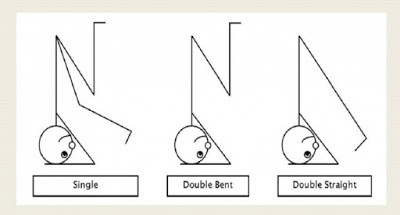
Q: There is a lot of controversy these days about the safety
of Headstand. What is your opinion about its safety?
A: Just recently, I read an article by Grace Bullock, Ph.D.,
E-RYT 500, Headstand and Neck Safety in Yoga: What You Need to Know about a recent study Sirsasana (headstand) technique alters head/neck loading:Considerations for Safety in the Journal of Bodywork & Movement
Therapies.
In the study, researchers in Austin, Texas, observed a group
of experienced yoga practitioners entering Headstand (Sirsasana), maintaining
the pose for 5 breaths, and then exiting the pose, using specialized techniques
and technology to measure the forces at work on the neck and head area. The practitioners
had one of three ways of moving into Headstand, as shown in the illustration above:
- straight legs going up together
- bent knees going up together
- bent knees, going up one at time
In all three groups, the amount of weight born by an
individual’s neck and head was 40-48% of his or her total body weight. This is
in contrast to the assertion is often made by yoga teachers that in this pose the
neck and head bear very little of the body weight and the arms bear most of it.
Now, can you imagine a 163 lb. person, like me, regularly carrying a 65-78lb.
weight around on the top of his head and it not leading to problems in his
neck?
They also observed that the longer the practitioners were in
the pose, the more weight their heads and necks were bearing, and they were
only in the pose for 5 breaths, around 30 seconds or so. Now, most classes I
attend that include Headstand have you in the pose for a minimum of two minutes.
So, using myself as an example again, this would mean that as time goes on the
weight on my head might start to be more like 80-90 pounds.
The investigators also were able to observe side-to-side
shifting of the weight on the head and neck during all three the phases of the
Headstand, and although it was less noticeable in those that could go up and down
with both legs straight, this side-to-side shifting did happen in all three
methods of moving into and out of the pose. And the more side-to-side shifting
that occurs, the higher the risk of injury is to the neck structures and
tissues.
Keeping in mind that these were all experienced practitioners
in the study, I can surmise that new and inexperienced practitioners are
likely to be putting much higher pressures on their necks and have a lot more
shifting of the weight on their necks in the learning process, thereby
increasing their chance of injury.
Following an incident where my car met a deer on a country
road a few years back, my neck did not come out of the encounter unscathed. So I have let go of Headstand, as it typically worsens my neck symptoms. I have also
dropped it from my teaching because of my concern that the risks of doing full
Headstand outweigh its benefits, especially in light of the safer poses I can
substitute in its stead, such as Forearm Balance (either Pinca Mayurasana or
“Headless Headstand”) or using a Headstander prop. Forearm Balance and using a
Headstander provide some of the same benefits of an inversion that Headstand provides, reversing the blood
flow and encouraging return of venous and lymphatic fluids, all without the risk of cervical injury. In addition, using the
Headstander prop for longer holds adds the calming and grounding effects some people experience with Headstand.
So this new study confirms my personal and professional preference
in this regard. And, in her article, Grace points out several other
contraindications to doing Headstand that are important to remember: osteoporosis/osteopenia,
hypertension, glaucoma, detached-retina, pregnancy, menstruation, cervical
injury or dysfunction, heart conditions, or other serious medical diagnoses.
Regular
readers of our blog know that I believe yoga is generally safe and well
tolerated by most people. But there may be a few exceptions, such as Headstand,
where we need to be more discriminating about who learns and practices it. If
you are going to practice Headstand, you may want to work towards the straight
legs entry and exit, as that method had slightly lower pressures on the neck
than the other two ways. Grace provides some good guidelines in her article,
which I agree with, that you can check out on your own at Headstand and Neck Safety in Yoga: What You need to Know.
—Baxter
Follow Yoga for Healthy Aging on Facebook ° To order Yoga for Healthy Aging: A Guide to Lifelong Well-Being, go to Amazon, Shambhala, Indie Bound or your local bookstore.


The only way I now do headstand is with a 4-block prop setup that puts a slight concavity in my thoracic spine and takes just about all the weight off my neck. Then I work on holding myself in the pose with arm/shoulder strength. Once the muscles start to give up, and I feel I'm collapsing onto my neck, I come out of headstand. I never do the tripod headstand anymore.
this block set up works great, i ve been using it on students who have issues, it was taught to me by a chiropractor iyengar yoga teacher. She said that it works great with students that have incurred whiplash…it helps to keep the shoulders well lifted and keeps thorax in…
Thank you so much for this article! I was appalled in a mixed class (experienced and total beginners) that I attended a few years ago where the instructor had absolute beginners do headstands in their first yoga class. Granted, many of them were a lot younger than this 68-year-old, but I thought it was irresponsible (and dangerous) for any yoga teacher to have them do headstands in their first couple of hours of yoga instruction. Wisdom on this topic as you have presented it should get wider circulation among yoga instructors.